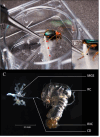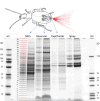Molecular basis of the explosive defence response in the bombardier beetle Brachinus crepitans
- PMID: 40400521
- PMCID: PMC12092131
- DOI: 10.1098/rsos.241823
Molecular basis of the explosive defence response in the bombardier beetle Brachinus crepitans
Abstract
Bombardier beetles have evolved a sophisticated and unique chemical defence mechanism involving controlled explosions within their paired defensive glands, producing a hot, benzoquinone-rich defensive spray. The molecular basis of this response is not well characterized. We therefore combined the transcriptomic and proteomic analysis of different gland compartments in the bombardier beetle Brachinus crepitans (Linnaeus, 1758) (Coleoptera, Carabidae) to identify abundant transcripts and gland-specific proteins with key defensive functions, such as catalases, peroxidases and enzymes involved in hydroquinone synthesis. By combining precise dissections with protein sequence analysis, we built a comprehensive atlas of the relevant proteins and their spatio-temporal organization. We found that glucose is important as a stable precursor of hydrogen peroxide and hydroquinone. These chemicals, together with gland-specific peroxidases and catalases, then initiate the explosive defence reaction. We also present evidence that the evolution of explosive secretions involved the functional adaptation of peroxidase genes involving atypical substitutions in otherwise highly conserved protein domains.
Keywords: Brachinus crepitans; bombardier beetles; chemical defence; hydrogen peroxide; hydroquinone; omics.
© 2025 The Author(s).
Conflict of interest statement
We declare we have no competing interests.
Figures



References
Associated data
LinkOut - more resources
Full Text Sources

